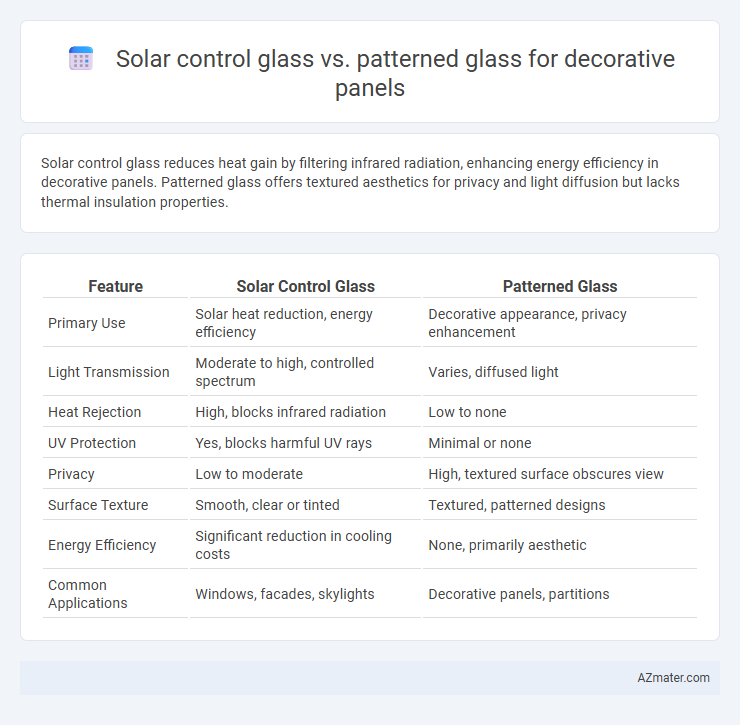Solar control glass reduces heat gain by filtering infrared radiation, enhancing energy efficiency in decorative panels. Patterned glass offers textured aesthetics for privacy and light diffusion but lacks thermal insulation properties.
Table of Comparison
| Feature | Solar Control Glass | Patterned Glass |
|---|---|---|
| Primary Use | Solar heat reduction, energy efficiency | Decorative appearance, privacy enhancement |
| Light Transmission | Moderate to high, controlled spectrum | Varies, diffused light |
| Heat Rejection | High, blocks infrared radiation | Low to none |
| UV Protection | Yes, blocks harmful UV rays | Minimal or none |
| Privacy | Low to moderate | High, textured surface obscures view |
| Surface Texture | Smooth, clear or tinted | Textured, patterned designs |
| Energy Efficiency | Significant reduction in cooling costs | None, primarily aesthetic |
| Common Applications | Windows, facades, skylights | Decorative panels, partitions |
Introduction to Decorative Glass Panels
Decorative glass panels enhance interior and exterior spaces by combining functionality with aesthetic appeal. Solar control glass offers energy efficiency by reducing heat gain and glare, ideal for environments requiring temperature regulation and comfort. Patterned glass provides textured designs that diffuse light and add privacy, making it suitable for decorative elements where visual interest and subtle light transmission are desired.
What is Solar Control Glass?
Solar control glass is designed with specialized coatings that reflect and absorb solar energy, reducing heat gain and improving energy efficiency in decorative panels by maintaining comfortable indoor temperatures. This type of glass enhances natural light transmission while minimizing glare and UV radiation, making it ideal for spaces requiring both aesthetic appeal and thermal performance. Patterned glass, in contrast, primarily offers decorative texture and privacy but lacks the thermal regulation properties inherent to solar control glass.
What is Patterned Glass?
Patterned glass is textured glass designed with various embossed patterns to enhance privacy and aesthetic appeal in decorative panels. Unlike solar control glass, which primarily reduces heat gain and glare through coated layers, patterned glass diffuses light while obscuring visibility, making it ideal for interior partitions or decorative applications. Its unique surface textures create visual interest and can complement modern architectural designs without compromising natural light.
Key Functional Differences
Solar control glass effectively reduces heat gain and glare by reflecting and absorbing solar radiation, making it ideal for energy-efficient decorative panels in sunny environments. Patterned glass enhances privacy and aesthetic appeal by diffusing light and obscuring vision without significant impact on thermal performance. The key functional difference lies in solar control glass prioritizing thermal regulation, while patterned glass emphasizes privacy and decorative texture.
Aesthetic Appeal: Design and Texture
Solar control glass offers a sleek, modern aesthetic with a smooth, reflective surface that enhances contemporary decorative panels while controlling light and heat transmission. Patterned glass provides unique textures and intricate designs that add depth and visual interest, creating a distinctive decorative element in interior and exterior applications. Choosing between solar control and patterned glass depends on prioritizing functional solar performance versus rich textural aesthetics for design impact.
Light Transmission and Privacy
Solar control glass offers a balanced combination of high light transmission and effective glare reduction, making it ideal for maintaining natural brightness while enhancing energy efficiency in decorative panels. Patterned glass provides increased privacy by diffusing light and obscuring visibility, resulting in moderate light transmission with a decorative texture. Choosing between the two depends on the desired level of privacy and light clarity in interior spaces.
Energy Efficiency and Thermal Comfort
Solar control glass enhances energy efficiency by reducing solar heat gain through its low-emissivity coatings, maintaining cooler indoor temperatures and lowering air conditioning costs. Patterned glass offers diffused natural light and privacy but lacks the advanced thermal insulation properties, leading to higher heat transfer and reduced thermal comfort. Choosing solar control glass for decorative panels maximizes both energy savings and indoor climate regulation compared to patterned glass.
Durability and Maintenance
Solar control glass offers superior durability due to its advanced coatings that resist UV rays, scratches, and weathering, making it ideal for long-term decorative panels requiring minimal maintenance. Patterned glass, while aesthetically versatile with textures that conceal fingerprints and smudges, is generally more prone to chipping and requires regular cleaning to maintain its visual appeal. Choosing solar control glass enhances panel longevity and reduces upkeep costs, especially in outdoor or high-exposure environments.
Cost Comparison and Long-Term Value
Solar control glass typically incurs higher upfront costs compared to patterned glass due to advanced coatings that reduce heat gain and improve energy efficiency. Patterned glass is generally more affordable initially but lacks the thermal performance benefits, potentially leading to higher energy expenses over time. Considering long-term value, solar control glass delivers better cost savings through reduced cooling loads and enhanced comfort, making it a more economical choice for decorative panels in energy-conscious buildings.
Choosing the Right Glass for Decorative Panels
Solar control glass offers superior energy efficiency by reducing heat gain and glare, making it ideal for decorative panels in sun-exposed areas. Patterned glass enhances privacy and adds textured aesthetic appeal, suitable for spaces requiring both decoration and subtle concealment. Choosing the right glass depends on balancing energy performance needs with design preferences and functional requirements of the space.

Infographic: Solar control glass vs Patterned glass for Decorative panel
 azmater.com
azmater.com